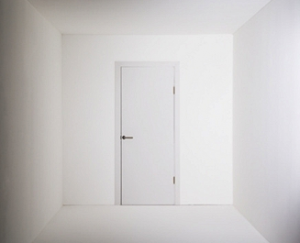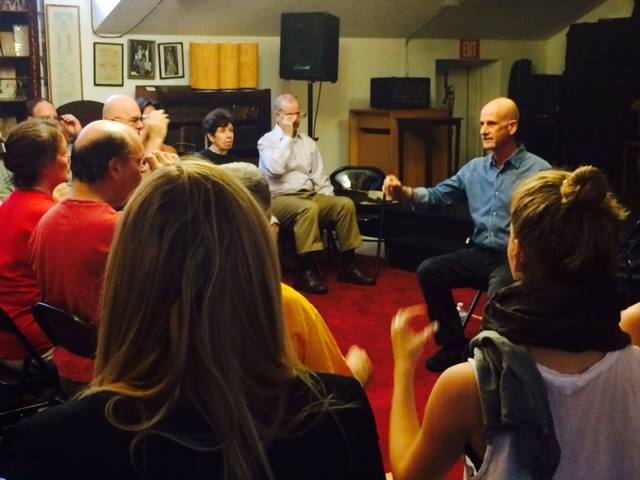One of my Alexander Technique students just returned from Paris. He described visiting a museum called “Musee L’Orangerie”.
Before you enter the main part of the museum, you enter an entirely white room. The room was designed by Monet to serve as a decompression chamber between the bustle of the city and his work (the Waterlilies).
This entirely white, empty, ‘pause’ room is a great metaphor for Alexander Technique’s inhibition.
Alexander Technique inhibition
Enter Alexander Technique’s ‘white room’ before you take a step, before you move your hand, before you do…anything. Start with a stop, or a gap, or a space. Otherwise, you will bring the ‘bustle of the city’ with you all the time, everywhere. Instead of bringing the bustle with you, why not bring the white room with you?
…to serve as a decompression chamber. Entering the realm of Alexander Technique’s version of inhibition helps you decompress and expand- physically and mentally.
How long do you have to stay in the white room to get the effect? Eventually only a fraction of a second. And, you don’t have to go all the way to Paris or anywhere else-the white room is within you, just as the Alexander Technique is within you. Alexander Technique inhibition doesn’t take up much space, because it is space. The white room gives you a chance to pause, to empty out.
Monet’s anterior white room invites vistors to “take the time to pause” (before entering). As my favorite Alexander Technique teacher Walter Carrington said: “I’ve got time.”
More Alexander Technique inhibition
The white room is a physical manifestation of where the Alexander Technique’s inhibition can take us. Here is a chance to be two places at once. Enter the white room while on the subway, while walking, as you put your fingers on the keyboard, before and during anything at all. Take the time, the space, and the room, to pause.
Alexander’s white room is always unlocked. You can enter from any direction, at any time. You can stay as long as you want, or as short as a twelfth of a second- a short session to lessen tension.
Alexander Technique inhibition creates a gap in between the past and the future, placing you in the present.
When should you enter Alexander Technique’s white room? Anytime you want. How do you know when you’re ready to leave the white room? You don’t. Leave anytime you like. You can’t get it wrong, and you can always go back in. It’s your room, the door is always open, the light is always on, the rent is free, and the goal is freedom.
Mark Josefsberg-Alexander Technique NYC
(917) 709-4648
Thanks to David May and Robin Casey











Love the metaphor. Curiously, even when doing constructive rest, I consistently “pause”. It seems a little contradictory to me to “pause” when I’m not actively doing anything, but as your article explains, it’s not just a pause before “doing” something, it’s a chance to step outside of your normal thinking, which is just as, or perhaps even more, applicable during constructive rest as any time else. Just an additional thought. Thanks for the article!
Thanks Michael,
I love the idea of pausing when you’re pausing! Stepping outside your normal thinking is a great way to think of it. Often, our normal thinking is running at 500 miles an hour. One of the great aspects of the Alexander Technique is to move away from normal when normal is not what we want. Normal can be habitually tensing our neck and slumping at the computer. The Alexander Technique helps us become aware of these ‘normal’ tensions, and teaches us how to release them. And yes, this is all tremendously applicable while doing Alexander Technique constructive rest.
Lovely! Thank you for this idea, Mark. It’s interesting to me that sometimes the idea of an empty inner enclosed space (room) to retreat to is very helpful; at other times, what I need most is the idea of unbounded space. I like that the two ideas are not mutually exclusive, either…as you said, the room is always unlocked. The “normal” room always has walls, but I think “my” room has optional walls.
Thank you Jennifer,
Inner space, outer space, walls, no walls-whatever works, right? I think it’s great if everyone had their own ideas about this because it helps internalize them. If switching works for you, then switch away! A teacher told me his student thinks of sorbet, to cleanse the palate.
A kitten, the ocean, nothing, everything, space, an atom-whatever works.
Thanks as always for your comments.
Absolutely loved this! Gave me space to breath and release and find bliss!
I’m so glad you liked it, Jane!
When I go to museums I notice how different rooms feel, and I love the image of the white room. The Michener Museum has a Nakashima room with rice paper walls and Nakashima’s hand crafted chairs and if I stop there first, I feel refreshed.
Thanks Margaret,
I like the idea that you feel refreshed. Maybe Coke isn’t the pause that refreshes. Maybe it’s the Alexander Technique inhibition that’s the real pause that refreshes!